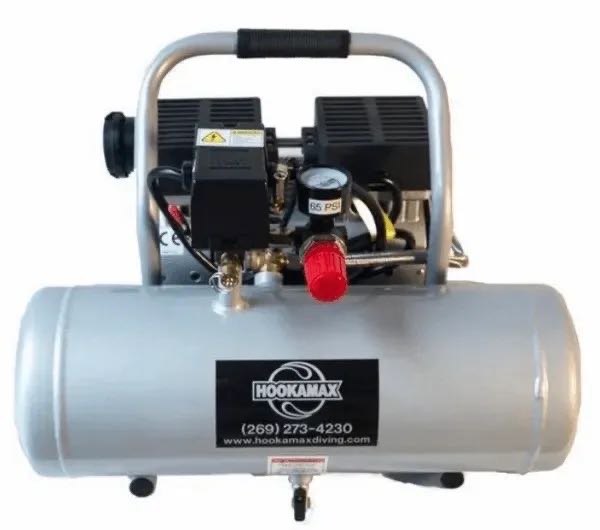Hull Cleaning
No matter what bottom paint you use, a hull is going to foul to some extent before you can get it hauled and the bottom repainted. A lot of folks will hire a diver to clean the hull periodically, say monthly or every other month. This can be an expensive prospect and it can be tricky to find a diver at your local marina. Back in the spring of 2018, when I first bought Kestrel, I didn’t give the bottom much thought. I had just done a haul out and pressure wash for the pre-purchase survey, and the bottom paint was in fair shape at the time. Later that summer, I had to jump in the water and untangle a crab pot line that wrapped around the rudder. While I was there, I noticed the buildup of barnacles on the hull which was telling me that the old bottom paint wasn’t really doing its thing anymore. I got Kestrel hauled late the next spring and had the bottom repainted.
Later that summer I noticed some marine growth on the waterline so jumped in the water to wipe it away. There was more than I thought there should be for only 2 months or so in the water. I also checked the prop while I was at it and found a bunch of small barnacles. Obviously, the paint I used on the prop wasn’t working well at all. Because I want to stretch out my haul-out interval to 2 years, I started making it a routine to at least dive and clean the running gear and the rudder to keep powering and steering performance good. This sounds easy enough, but in practice I had a hard time because I could only do so much prop cleaning per breath. It was a slow and exhausting process to just keep the prop clean. Later, I found that the hull needed attention too which turned into a huge effort.
This led me to my friends Google and YouTube where I came across videos of folks using a hookah air supply to get around the whole holding your breath problem of hull cleaning. I was already familiar with the work of cleaning my hull, having done it a fair bit at that point. I figured that buying a Hookah would make that job easier. I was correct in that, but it still isn’t an easy job.
After a lot more Googling, I decided to purchase a Hookah from Hookamax Dive Systems. I went back and forth on AC versus DC power and finally decided on the AC version. My thought was that I would primarily use it at the dock where I have ready access to 110V AC power. If I ever wanted to use it at anchor, I could always get an inverter. So far, I haven’t felt the urge to clean my hull at anchor mostly because my time at anchor is limited and far too precious to waste cleaning the hull. I’ve had the unit for three seasons now and am pleased with its performance.
The Stew
Hull cleaning with or without an air supply is not for the faint of heart. What videos don’t relate is the physicality of the work and how nasty it can be. In my part of the Chesapeake and most that I’ve sailed on, the water is green and extremely murky. The visibility can be measured in inches on a good day, at least when its warm enough to get in the water. This means that when I’m cleaning my hull, I’m doing it blind and by feel. This sounds bad, but the alternative I think might be worse. When you are rubbing or scraping the growth from the bottom, said growth floats in the water, and you are basically bathing in it. Considering the proximity of your hands to your head this means that your face is right in the middle of that stew. Oh, you might be thinking that we’re just talking about algae, little plant like things right? No, that is only part of it. A good part of that growth are critters that squirm about, latch on and crawl around on you, get in your hair, and crawl inside your suit. I’ve done it enough that I only get mildly disgusted by it when I get out of the water and have to hose myself and immediately take a shower. I think it would be a lot worse if I could see them swarming around my face while I was doing the work.
The Jellyfish
Then there are the jellyfish. At the height of the summer and through September, the jellies are abundant which tended to make be shy away from cleaning the hull. I tried waiting them out and doing my cleaning later in September, but there were still enough to get me. Again, Google was my friend and I discovered Jellysuits. These are basically spandex dive suits that go from ankle to neck. I added a nylon (spandex) dive hood and nylon dive socks to the mix after: 1) Getting stung on the neck a bunch, and 2) Trying to clean critters off of regular socks I wore on one dive. This combination isn’t 100% fool proof as I did manage to catch a stinging tentacle across my lip at one point. Luckily, the jellies of the Chesapeake are annoying and not deadly like the ones in Australia.
The Current
Then there is the current. My slip is exposed to a strong tidal current. I time my dives to start the hour before high or low tide when the current is minimal. I have started running two lines from the bow, one on each side, crossing at the keel, tied on opposite sides of the stern. This gives me a something to hang onto when I’m under the boat. I used to use flippers to swim around, but found that my legs would start to cramp pretty bad about halfway through a cleaning. By getting rid of the flippers and using the ropes, my legs only start to cramp at the end of the 2 hours it takes me to clean. For the waterline and as far as I can reach below from the surface, I use an automotive suction cup dent puller to hold onto the side of the boat. I use to use ropes there too, but the suction cup works better for me.
Exhaustion
Then there is the exhaustion. I am not a young fellow anymore, but I’m not ancient either. I’m nearing 60 as of this writing and and a desk jockey by trade so not the most active. Cleaning a hull bottom is pretty physical. You are basically rubbing or scraping a vast surface area while holding on mostly upside down to various things (keel, prop shaft, rudder, ropes, suction cup) for purchase with one hand and kicking your feet to keep your orientation. It is an all body workout that lasts a couple hours without break. I say without break because once I start, I don’t get out of the water until I’m done as the first thing I’m going to do out of the water is get the critters off of me and out of my suit. I’m not doing that more than once.
Implements of Destruction
First, I always protect my hands with cloth work gloves. They will wear when working on barnacles so you may have to replace them after a couple of cleanings. Second, I use a mask to keep the water out of my eyes and nose (mostly). The level of fouling will drive the tools I use:
- Very Light – rag of some relatively rough material like and old dish towel
- Medium with no or very small barnacles – Scotch-Brite scrubbing pad – the bigger the better. Have plenty on the swim platform because you will drop them. In my waters, you drop it you lose it. I’ve gone down to the bottom to try and find lost tools, but the visibility is so bad, it is virtually impossible.
- Medium with smallish barnacles – a combination of wide metal putty knife and a Scotch-Brite pad. Be sure to make a good lanyard that will keep the putty knife attached to your wrist.
- Heavy – a painter’s 5-in-one tool and a Scotch-Brite pad. Again, remember the lanyard.
Any metal will rust very quickly after being in the water. Rinse everything with fresh water and spray metal with WD-40 after every use without exception.
But Why?
If you’ve made it all the way to the end of this post you are probably wondering why in God’s name is this guy going through all of this three times a summer? Truthfully, after writing it I am wondering about that myself. I could put the hookah up for sale on eBay or Craigslist and use the money to pay a diver for a couple years. Honestly, I am a hands on guy. I like to build and take care of things. At some point, if I can’t do this anymore, I’ll hire a diver or sell Kestrel. Until then, I’ll be refining my hull cleaning techniques every summer for the foreseeable future.


